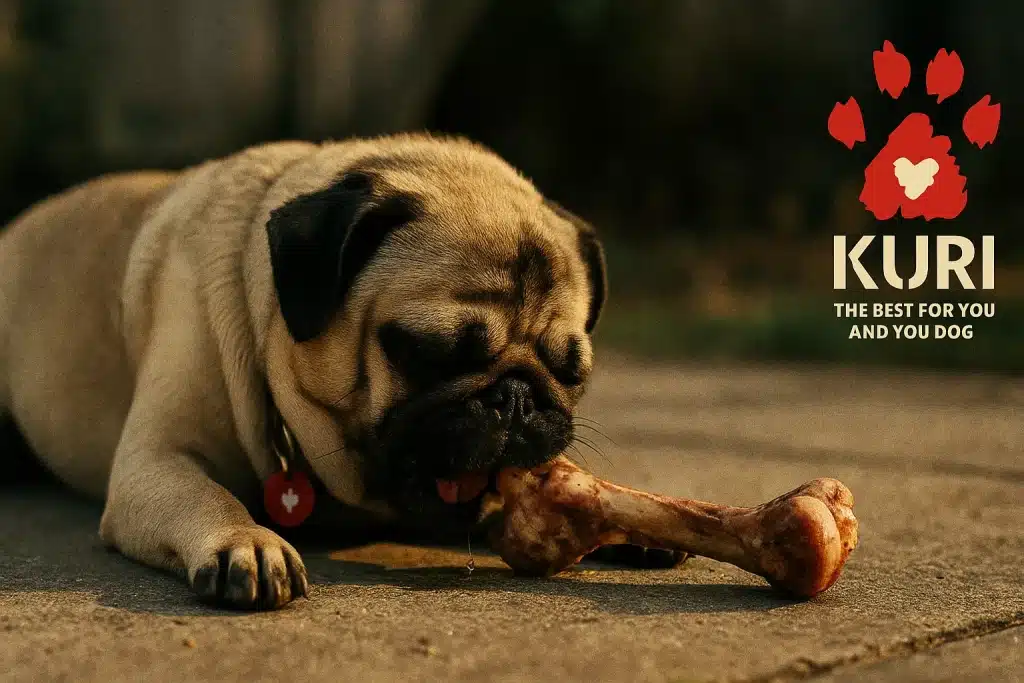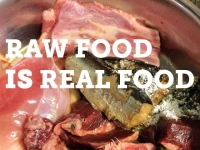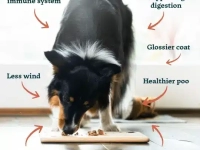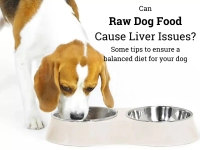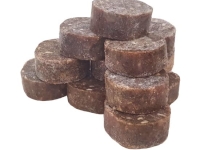Raw Feeding & Dog Food Allergies: How Raw Food Can Help!
In This Article...
THE OVERVIEW...
What is a Raw Food Diet for Dogs?
Benefits of Raw Feeding
Feeding raw food to dogs, commonly known as raw feeding, offers numerous benefits that can enhance your pet’s health and vitality. A raw food diet is rich in essential nutrients and enzymes that are often lost during the processing of commercial pet foods. This diet can lead to improved digestion, healthier skin and coat, increased energy levels, and stronger immune function. Moreover, feeding raw meat and whole food ingredients can help maintain lean muscle mass due to the high-quality protein content. By providing a balanced diet tailored to your dog’s needs, raw feeding may also reduce the occurrence of food allergies and itchy skin, offering relief to dogs with allergies.
Beyond the physical health benefits, raw feeding can also enhance your dog’s mental well-being. The act of chewing raw meat and bones can provide mental stimulation and help alleviate boredom, which can be particularly beneficial for active or working breeds. Additionally, the natural enzymes found in raw foods can promote dental health by reducing plaque build-up and preventing periodontal disease. As pet owners look to improve their dogs’ overall quality of life, raw feeding presents a holistic approach that supports both physical and mental health. However, it’s crucial to ensure a balanced diet to avoid nutritional deficiencies, making it essential to understand the components of a raw food diet.
Components of a Balanced Diet in Raw Feeding
A balanced diet in raw feeding consists of various components that ensure your dog receives all the necessary nutrients. The primary ingredient in a raw food diet is high-quality protein, often sourced from raw meat such as beef, chicken, or lamb. This protein source is essential for muscle development and overall health. Additionally, raw feeding includes organ meats, which are rich in vitamins and minerals, and bones that provide calcium and phosphorus. To achieve a balanced diet, pet owners could also incorporate vegetables and fruits, which supply fibre and antioxidants, and supplements like fish oil for omega-3 fatty acids.
Creating a balanced diet requires careful consideration of the proportions and variety of ingredients. It’s important to include novel protein sources, especially for dogs with food allergies, to prevent allergic reactions. A single protein diet may be beneficial for identifying food allergies in dogs, as it simplifies the diet and makes it easier to pinpoint allergens. Pet owners should also be aware of the potential need for additional supplements to address specific nutritional gaps. Consulting with a veterinarian or a pet nutritionist can help ensure that the raw food diet meets all of your dog’s dietary needs, supporting optimal health and minimizing the risk of allergies.
How to Introduce Raw Foods to Your Dog
Introducing raw foods to your dog’s diet should be a gradual process to ensure a smooth transition and minimize digestive upset. Start by incorporating small amounts of raw food alongside your dog’s current diet, gradually increasing the proportion of raw food over one to two weeks. This allows your dog’s digestive system to adjust to the new food sources and reduces the likelihood of gastrointestinal issues. Monitoring your dog for any signs of allergy symptoms, such as itchy skin or skin irritation, is crucial during this period to ensure the chosen raw diet is suitable.
When introducing raw foods, it’s important to select high-quality ingredients and maintain proper hygiene to prevent contamination. Begin with a single protein source, such as chicken or beef, to gauge your dog’s tolerance and identify any potential food allergens. If your dog is allergic to certain foods, consider using a novel protein diet to eliminate common food allergens and reduce the risk of allergic reactions. As you progress with raw feeding, adjust the diet based on your dog’s response and nutritional needs, and consult with Kuri specialists to ensure a balanced diet that supports your dog’s health and well-being.
How Can Raw Feeding Help with Food Allergies in Dogs?
Identifying Allergy Symptoms in Dogs
Recognising allergy symptoms in dogs is the first step in addressing food allergies effectively. Common signs include itchy skin, ear infections, gastrointestinal issues, and chronic skin irritation. These symptoms can be caused by various allergens found in commercial pet foods, making it essential to identify the specific triggers. A dog may also exhibit behavioural changes such as increased scratching or licking, which could indicate an allergic reaction. By observing these symptoms, pet owners can take action to modify their dog’s diet and explore the benefits of raw feeding.
Early identification of allergy symptoms not only aids in effective management but also prevents secondary health issues from developing. Chronic allergies can lead to persistent discomfort, skin infections, and even behavioural changes due to constant irritation. Engaging in regular health check-ups and consulting with veterinarians can provide valuable insights into potential allergies and guide pet owners in choosing the right dietary approach. By employing a methodical approach to identifying and addressing allergies, pet owners can significantly improve their dog’s quality of life and overall health. Through careful observation and timely intervention, the journey towards managing allergies becomes more navigable and less daunting.
The Role of a Novel Protein Diet
A novel protein diet plays a crucial role in managing food allergies in dogs by eliminating common food allergens and introducing new protein sources. This approach involves selecting proteins that your dog has not previously been exposed to, such as venison, lamb, or rabbit, which are less likely to trigger allergic reactions. By feeding a novel protein diet, pet owners can effectively reduce the likelihood of allergic reactions and improve their dog’s overall health. This diet is particularly beneficial for dogs with a history of allergies, as it provides a fresh start and minimizes exposure to known allergens.
Implementing a novel protein diet requires careful planning and consideration of your dog’s dietary history. It’s important to ensure that the chosen protein source provides all the essential nutrients your dog needs for a balanced diet. In some cases, pet owners may need to supplement the diet with additional vitamins or minerals to prevent deficiencies. Monitoring your dog’s response to the novel protein diet is crucial, allowing for adjustments as needed to achieve optimal health outcomes. Through diligent observation and adaptation, a novel protein diet can significantly alleviate food allergies and enhance your dog’s quality of life.
Raw Feeding vs. Commercial Diets for Allergic Dogs
When comparing raw feeding to commercial diets for dogs with allergies, raw feeding offers distinct advantages due to its natural and customisable nature. Raw diets allow pet owners to control the ingredients, avoiding common food allergens and tailoring the diet to their dog’s specific needs. This level of customisation is often not possible with commercial dog foods, which contain yeast, fillers, preservatives, artificial additives and rancid fats that can exacerbate allergies. Additionally, raw feeding provides whole food ingredients that retain their natural nutrients, supporting better digestion and overall health.
While commercial diets may offer convenience, they often lack the flexibility and nutritional integrity that raw feeding provides. For dogs with allergies, minimizing exposure to potential allergens is crucial, and raw feeding allows for greater control over the diet’s composition. Furthermore, the freshness and variety of raw foods can enhance palatability and encourage better eating habits in dogs. However, it’s essential for pet owners to ensure that the raw diet is balanced and meets all nutritional requirements, which may require guidance from a pet nutritionist. By choosing raw feeding, pet owners can provide a hypoallergenic diet that supports their dog’s health and well-being.
What are Common Food Allergens in Dog Diets?
Understanding Food Allergens in Dog Food
Food allergens in dog food can trigger a range of allergic reactions, making it important for pet owners to understand these common culprits. Proteins are the most frequent allergens, with beef, chicken, and dairy being among the top offenders. Grains such as wheat, corn, and soy can also cause allergies in some dogs. Understanding these common food allergens allows pet owners to make informed choices when selecting pet food, reducing the risk of allergy symptoms and improving their dog’s health.
Identifying food allergens is a critical step in managing food allergies effectively. By recognising the ingredients that commonly cause allergic reactions, pet owners can avoid these components in their dog’s diet, opting for hypoallergenic or novel protein options instead. This proactive approach not only alleviates existing symptoms but also prevents future allergic responses, ultimately leading to a healthier and more comfortable life for the dog. The knowledge of food allergens empowers pet owners to take control of their dog’s dietary needs and create a safer, more nourishing environment through careful selection and preparation of meals.
Identifying if Your Dog is Allergic to Certain Foods
Identifying food allergies in dogs involves careful observation of symptoms and dietary patterns. If your dog exhibits allergy symptoms such as itchy skin, gastrointestinal distress, or ear infections, it may indicate a food-related issue. Conducting an elimination diet can help pinpoint the specific allergen by systematically removing potential culprits from the diet and reintroducing them one at a time. This process requires patience and attention to detail, as it involves monitoring your dog’s response to each new food introduced.
Engaging in a detailed and methodical approach to identify food allergies is vital for effective management and prevention. Through the use of elimination diets, pet owners can systematically isolate the source of allergies, thereby allowing for a more targeted and successful dietary intervention. This individualised approach not only alleviates immediate symptoms but also promotes long-term health and well-being.
How to Conduct a Food Trial for Allergies
Conducting a food trial is an effective method for identifying food allergies in dogs and typically involves a structured diet trial using a hypoallergenic or novel protein diet. The trial lasts for about 8 to 12 weeks, during which the dog is exclusively fed the selected diet without any other treats or foods. This strict adherence allows for the observation of allergy symptoms and their potential resolution. After the trial period, individual food items are gradually reintroduced to identify which ones trigger allergic reactions.
Embarking on a food trial requires commitment and meticulous tracking of dietary intake and symptoms. The primary goal is to achieve a clear understanding of how different foods impact your dog’s health, enabling the identification of specific allergens. By eliminating variables and focusing on a controlled diet, pet owners gain valuable insights into their dog’s unique dietary needs and tolerances. This comprehensive approach not only identifies allergens but also informs future dietary choices, ensuring a balanced and allergy-free lifestyle. The knowledge acquired from a food trial empowers pet owners to make informed decisions, promoting a healthier and happier life for their dogs.
Is a Raw Diet Safe for Dogs with Allergies?
Risks and Benefits of Feeding Raw Meat
Feeding raw meat to dogs with allergies presents both risks and benefits that pet owners must consider. The benefits of a raw diet include improved digestion, enhanced skin and coat health, and reduced allergy symptoms due to the use of whole food and novel protein sources. Raw feeding allows for the elimination of common food allergens found in commercial diets, which can significantly alleviate allergy symptoms.
To mitigate the risks associated with raw feeding, pet owners must prioritise hygiene and proper food handling. Ensuring that raw meat is sourced from reputable suppliers and stored correctly can minimize the risk of bacterial infections. Additionally, working with a pet nutritionist can help create a balanced diet that meets all of your dog’s nutritional needs. By carefully weighing the risks and benefits, pet owners can make informed decisions about feeding raw meat, ultimately supporting their dog’s health and well-being while managing allergies effectively.
How to Ensure a Hypoallergenic Diet
Ensuring a hypoallergenic diet for dogs involves careful selection of ingredients and monitoring for allergic reactions. A hypoallergenic diet typically includes novel protein sources and avoids common food allergens such as beef, chicken, and dairy. Pet owners should focus on providing a balanced diet that meets their dog’s nutritional needs while minimising the risk of allergic reactions. This may involve incorporating novel protein diets, single protein sources, and whole food ingredients to create a safe and nourishing diet.
Achieving a hypoallergenic diet requires ongoing vigilance and adaptability. Pet owners must remain attentive to their dog’s health and be prepared to adjust the diet based on any observed allergic reactions or changes in symptoms. Regular consultations with a veterinarian can provide valuable guidance and ensure that the diet remains balanced and effective in managing allergies. By taking a proactive approach, pet owners can create a hypoallergenic diet that not only addresses allergy symptoms but also promotes overall health and well-being. Through careful planning and commitment, a hypoallergenic diet becomes a cornerstone of a healthier lifestyle for dogs with allergies.
Monitoring Your Dog for Allergic Reactions
Monitoring your dog for allergic reactions is a critical aspect of managing food allergies effectively. Regular observation of allergy symptoms, such as itchy skin, digestive issues, and changes in behaviour, can help pet owners identify potential allergens and adjust the diet accordingly. Keeping a detailed record of your dog’s diet and any observed reactions is essential for identifying patterns and making informed dietary choices.
Consistent monitoring not only aids in immediate symptom relief but also contributes to long-term health management. By diligently tracking dietary intake and responses, pet owners can refine their approach to feeding, ensuring that their dog’s diet remains both balanced and allergy-friendly. This ongoing commitment to observation and adjustment empowers pet owners to proactively address allergies, minimising discomfort and enhancing overall quality of life. The practice of vigilant monitoring transforms the management of food allergies into a dynamic and responsive process, fostering a healthier and more harmonious relationship between pet and owner.
How to Transition Your Pet to a Raw Dog Food Diet?
Steps to Feeding a Raw Diet for Beginners
Transitioning your pet to a raw dog food diet involves several steps to ensure a smooth and successful change. Begin by researching and selecting high-quality raw pet foods that meet your dog’s nutritional needs. Gradually introduce raw food by mixing small amounts with your dog’s current diet, increasing the proportion of raw food over one to two weeks. This gradual transition helps your dog’s digestive system adjust to the new diet and reduces the risk of gastrointestinal issues. During this period, closely monitor your dog’s reaction to the new food, watching for any signs of allergy symptoms or digestive upset.
The process of transitioning to a raw diet requires patience and attention to detail. As you increase the proportion of raw food, ensure that your dog’s diet remains balanced, incorporating a variety of protein sources, vegetables, and supplements as needed. This careful approach not only supports digestive adaptation but also fosters a positive and enjoyable feeding experience. By taking the time to transition thoughtfully, pet owners can help their dogs reap the full benefits of a raw food diet, from improved health to enhanced vitality.
Choosing the Right Protein Source for Your Dog
Choosing the right protein source is a crucial aspect of feeding a raw diet, as it directly impacts your dog’s health and the effectiveness of allergy management. When selecting proteins, consider your dog’s specific dietary needs and any existing food allergies. Novel protein sources, such as venison, lamb, or rabbit, can be beneficial for dogs with allergies, as they are less likely to trigger allergic reactions. Additionally, rotating protein sources can help prevent the development of new food allergies and ensure a balanced intake of nutrients.
The selection of protein sources is a dynamic process that requires ongoing evaluation and adaptation. By regularly assessing your dog’s health and nutritional needs, pet owners can make informed choices that enhance the overall effectiveness of the diet. The variety and quality of protein sources not only contribute to the nutritional balance but also improve palatability, encouraging better eating habits and enjoyment. Through careful selection and thoughtful consideration, choosing the right protein source becomes a key factor in the success of a raw feeding regimen, ultimately contributing to a healthier and more fulfilling life for your dog.
Common Challenges in Raw Feeding and How to Overcome Them
Raw feeding presents several challenges that pet owners must navigate to ensure a successful transition and maintain a balanced diet. One common challenge is ensuring the diet provides complete nutrition, as raw feeding requires careful planning to include all essential nutrients. To overcome this, dog owners can rotate through a range of Kuri Raw Dog Food recipes to develop a comprehensive feeding plan. Another challenge is managing the risk of bacterial contamination, which can be addressed by practicing proper food handling and hygiene.
Addressing the challenges of raw feeding requires a proactive and informed approach. By investing time in research and seeking professional guidance, pet owners can confidently navigate the complexities of raw feeding. Maintaining a clean and organized feeding area, sourcing high-quality ingredients, and regularly reviewing the diet’s nutritional adequacy are essential practices for overcoming challenges. Additionally, fostering a community of support among fellow raw feeders can provide valuable insights and encouragement. Through diligence, education, and collaboration, pet owners can successfully overcome the challenges of raw feeding, ensuring their dogs enjoy a nutritious and satisfying diet.
For support and advice, pop into store or Email Us
Frequently Asked Questions
How can raw food help pets with food allergies?
Feeding your dog a raw diet with a novel protein can help manage food allergies by eliminating common allergens found in processed foods. A complete diet made from whole, natural ingredients can support your dog’s immune system and reduce allergy symptoms.
Can dogs and cats both benefit from a raw diet?
Yes, both dogs and cats can benefit from a raw diet. A natural diet tailored to their nutritional needs can improve overall health and reduce the risk of allergies and other health issues.
Are raw chicken diets suitable for dogs that are allergic to chicken?
Dogs that are allergic to chicken should not be fed raw chicken. It’s essential to choose a diet with a novel protein that your dog has not been exposed to previously to avoid triggering allergies.
What are the signs of dog allergies to be aware of?
Common signs of dog allergies include itching, redness, ear and skin infections, vomiting, diarrhoea, and excessive licking or scratching. If you notice these symptoms, consult a vet for a proper diagnosis.
How can switching to a raw diet impact a dog’s allergy symptoms?
Switching to a raw diet can alleviate allergy symptoms by removing processed ingredients and allergens. A natural, complete diet can help strengthen the dog’s immune system and improve overall health.
Are environmental allergies different from food allergies in dogs?
Yes, environmental allergies are caused by external factors like pollen, dust, or mold, while true food allergies result from an adverse reaction to something in the food. Both can cause similar symptoms, making proper diagnosis important.
Can adult dogs develop new food allergies?
Yes, adult dogs can develop new food allergies over time. It’s important to monitor your dog’s health and consult with a veterinarian if you suspect an allergy.
Are commercial raw pet food options a good choice for dogs with allergies?
Commercial raw pet food options can be beneficial for dogs with allergies, provided they contain novel proteins and are free from common allergens. Ensure the diet is complete and balanced for your dog’s needs.


